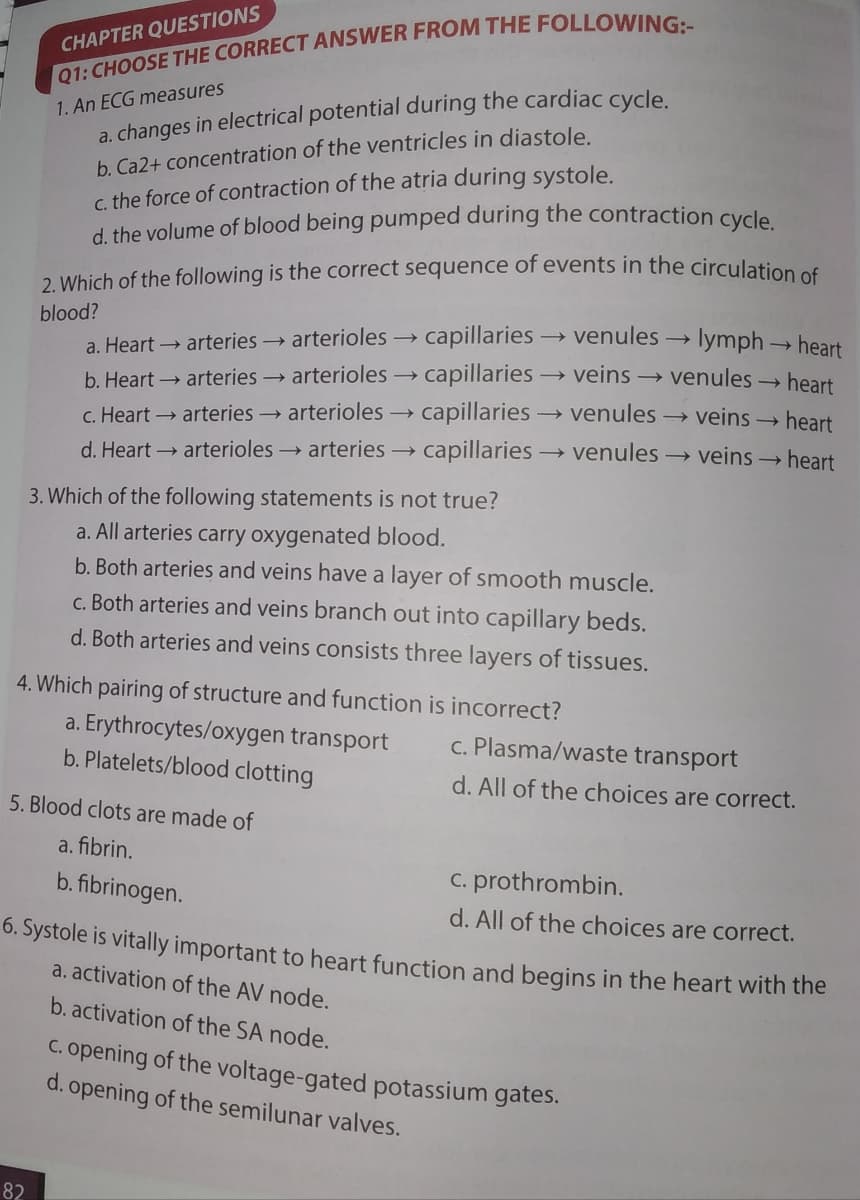CHAI Q1: CHOOSE THE CORRECT AN 1. An ECG measures a. changes in electrical potential during the cardiac cycle b. Ca2+ concentration of the ventricles in diastole. C. the force of contraction of the atria during systole. d. the volume of blood being pumped during the contraction cycle
CHAI Q1: CHOOSE THE CORRECT AN 1. An ECG measures a. changes in electrical potential during the cardiac cycle b. Ca2+ concentration of the ventricles in diastole. C. the force of contraction of the atria during systole. d. the volume of blood being pumped during the contraction cycle
Anatomy & Physiology
1st Edition
ISBN:9781938168130
Author:Kelly A. Young, James A. Wise, Peter DeSaix, Dean H. Kruse, Brandon Poe, Eddie Johnson, Jody E. Johnson, Oksana Korol, J. Gordon Betts, Mark Womble
Publisher:Kelly A. Young, James A. Wise, Peter DeSaix, Dean H. Kruse, Brandon Poe, Eddie Johnson, Jody E. Johnson, Oksana Korol, J. Gordon Betts, Mark Womble
Chapter20: The Cardiovascular System: Blood Vessels And Circulation
Section: Chapter Questions
Problem 10RQ: Which of the following statements is true? The longer the vessel, the lower the resistance and the...
Related questions
Question
100%

Transcribed Image Text:CHAPTER QUESTIONS
a. changes in electrical potential during the cardiac cycle
b. Ca2+ concentration of the ventricles in diastole.
c. the force of contraction of the atria during systole.
d. the volume of blood being pumped during the contraction cycle
1. An ECG measures
2. Which of the following is the correct sequence of events in the circulation of
blood?
a. Heart → arteries → arterioles → capillaries → venules → lymph→ heart
b. Heart → arteries arterioles → capillaries → veins → venules → heart
C. Heart → arteries arterioles → capillaries → venules → veins → heart
d. Heart → arterioles→ arteries → capillaries → venules → veins → heart
3. Which of the following statements is not true?
a. All arteries carry oxygenated blood.
b. Both arteries and veins have a layer of smooth muscle.
c. Both arteries and veins branch out into capillary beds.
d. Both arteries and veins consists three layers of tissues.
4. Which pairing of structure and function is incorrect?
a. Erythrocytes/oxygen transport
b. Platelets/blood clotting
c. Plasma/waste transport
d. All of the choices are correct.
5. Blood clots are made of
a. fibrin.
b. fibrinogen.
C. prothrombin.
d. All of the choices are correct.
6. Systole is vitally important to heart function and begins in the heart with the
a. activation of the AV node.
b. activation of the SA node.
C. opening of the voltage-gated potassium gates.
d. opening of the semilunar valves.
82
Expert Solution
This question has been solved!
Explore an expertly crafted, step-by-step solution for a thorough understanding of key concepts.
Step by step
Solved in 3 steps

Knowledge Booster
Learn more about
Need a deep-dive on the concept behind this application? Look no further. Learn more about this topic, biology and related others by exploring similar questions and additional content below.Recommended textbooks for you

Anatomy & Physiology
Biology
ISBN:
9781938168130
Author:
Kelly A. Young, James A. Wise, Peter DeSaix, Dean H. Kruse, Brandon Poe, Eddie Johnson, Jody E. Johnson, Oksana Korol, J. Gordon Betts, Mark Womble
Publisher:
OpenStax College

Cardiopulmonary Anatomy & Physiology
Biology
ISBN:
9781337794909
Author:
Des Jardins, Terry.
Publisher:
Cengage Learning,


Anatomy & Physiology
Biology
ISBN:
9781938168130
Author:
Kelly A. Young, James A. Wise, Peter DeSaix, Dean H. Kruse, Brandon Poe, Eddie Johnson, Jody E. Johnson, Oksana Korol, J. Gordon Betts, Mark Womble
Publisher:
OpenStax College

Cardiopulmonary Anatomy & Physiology
Biology
ISBN:
9781337794909
Author:
Des Jardins, Terry.
Publisher:
Cengage Learning,
